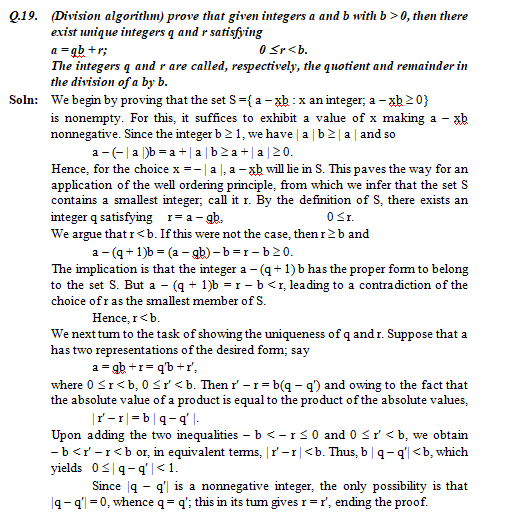Course Outlines
Divisibility theory
Division algorithm
Euclidean algorithm
Diophantine equation
Primes and their distributions
Unique factorization theorem
Goldbach's conjecture
Theory of congruence
Properties of congruence
Divisibility tests
Linear congruence
Fermat's little theorem and Wilson's theorem
Euler's theorem.
· Well
ordering principle: Every non-empty set S of non-negative integers contains a
least element, i.e., there is some integer a in S such that a £ b for all a, b Î S.
· Archimedean
property: If a and b are any positive integers, then there exists a
positive integer n such that na ³ b.
· Principle
of finite induction: Let S be a set of positive integers with the properties
(i) 1 belonging to S and (ii) whenever
the integer k is S, then the next integer K + 1 must also be in S, and set S is
the set of all positive integers.
· Division
Algorithm: Given integers a and b, with b > 0, there exist unique
integers q and r satisfying a
= qb + r 0 £ r < b.
The integers q and r are called,
respectively the quotient and remainder in the division of a by b.
· Greatest
common divisor: Let a and b be given integers, with at least one of them
different from zero. The greatest common divisor of a and b denoted by gcd (a,
b) is a positive integer d satisfying
i) d|a and d|b
ii) if c|a and c|b, then c £ d.
· The Diophantine
equation: The equation of the form ax + by = c where a, b, c are
integers and a, b not both zero.
The Diophantine equation ax + by = c
admits a solution iff d|c where d = gcd
(a, b).
· Prime
number: An integer p > 1 is called a prime number, or simply a
prime if its only positive divisors 1 and p. An integer greater than 1 which is
not prime is termed composite.
· Twin
prime: The pair of successive odd integers p and p + 2 which are
both primes are called twin primes. For example 3 and 5, 5 and 7, 11 and 13 etc
are twin primes.
· Congruence
modulo n: Let n be a fixed positive integer. Two integers a and b are
said to be congruent modulo n, symbolized by a º b (mod n)
If n divides the difference a – b;
that is provided that a – b = Kn for
some integer k.
· Fermat's
Little theorem: If p is a prime and p ![]() a, then
ap –1 º 1 (mod
p).
a, then
ap –1 º 1 (mod
p).
· Fundamental
theorem of arithmetic: Every positive integer n > 1 can be expressed as a
product of primes, this representation is unique, apart form the order in which
the factors occur.
· Relatively
prime: Two integers a and b, not both of which are zero are said
to be relatively prime whenever gcd (a, b) = 1.
· Wilson's
theorem: If p is a prime integer than (p – 1) ! º – 1 (mod p).
Some Solved Problems
Q.1. Use Euclidean Algorithm to express gcd (4076, 1024) as a linear
combination of 4076 and 1024. [T.U.
2075]
Soln: To find gcd
(4076, 1024):
By the successive
application of division algorithm, we have
4076 = 3 ´ 1024 + 1004
1024 = 1 ´ 1004 + 20
1004 = 50 ´ 20 + 4
20 = 5 ´ 4 + 0
Since the last non-zero remainder is 4, gcd (4076, 1025)
= 4.
To express
gcd (4076, 1024) as linear combination of 4076 and 1025:
We have,
gcd (4076, 1024) = 4
=
1004 – 50 ´ 20
= 1004 -
50(1024 - 1 ´ 1004) [ ∵
20 =
1024 - 1 ´ 1004]
= 1004 - 50 ´ 1025 + 50 ´ 1004
= 51 ´ 1004 - 50 ´ 1024
= 51 (4076 - 3 ´ 1024) - 50 ´ 1024 [∵ 4076 - 3´1024 = 1004] = 51 ´ 4076 - 153 ´ 1024 - 50 ´ 1024
= 51 ´ 4076 - 203 ´ 1024
= 51 ´ 4076 + (-203) ´ 1024)
\ gcd (4076, 1024) = 51 ´ 4076 + (-203) ´ 1024 Ans.





















0 Comments